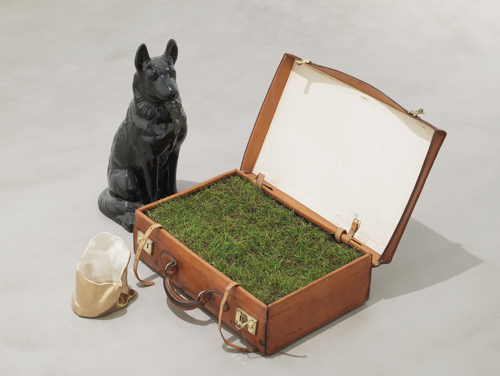Kemang Wa Lehulere
Gasworks, London, UK
Gasworks, London, UK

Visitors encountered four vintage leather suitcases placed on the floor throughout ‘Sincerely yours,’ South African artist Kemang Wa Lehulere’s first London exhibition, which inaugurated the redeveloped gallery at Gasworks, a non-profit exhibition space and residency programme. Titled in a sequence – Do not go far, they say; Do not go far, they say, again; Do not go far, they say, again, 2; Do not go far, they say, again, 3; and Do not go far, they say, again, 4 (all 2015) – the cases were filled with soil, out of which grew a layer of grass. While the weight of such baggage hinted at how difficult it would be to carry it any considerable distance, the unpredictable growth pattern of the fresh grass suggested a freedom of sorts. Each of the suitcases was watched over by a group of ceramic ornaments in the shape of German shepherds, police guard dogs par excellence, whose upright postures recalled animal sentinels guarding the dead in ancient civilizations. Painted either gold or black, some of the dogs had been smashed and their shattered remains strewn on the floor.
On the main wall, facing the gallery entrance, a painted black rectangle formed the background for four blackboards. Attached to wedge-shaped wooden frames, hung so that they sloped alternately towards the ceiling and towards the floor, each bore a fragment of an image or text drawn in chalk. The first featured a vignette of musical notation for the song ‘Forget Me Not’, the second a detail from an architectural drawing of a Corinthian capital, the third a sort of choreographic diagram with blurred areas of chalk dust, and the fourth partially erased stage directions for ‘Scene 13. EXT. SOMEWHERE. NIGHT’ along with a sketch of a stage with a mound of indistinct matter on it. These blackboard ramps reappeared throughout the exhibition, presenting other textual and pictorial snippets. One of them hung alongside two empty wooden hanging brackets, suggesting the possibility of rearranging the blackboards to generate different narratives. Another showed a heavily redacted letter from the artist to an unknown recipient, from which could be gleaned little more than the year 1914, the name of the South African intellectual Sol T. Plaatje and an unspecified bit of ‘good news’.
Information provided by the gallery revealed that Wa Lehulere’s exhibition interwove his own experience of growing up in South Africa with Plaatje’s early-twentieth-century account of seeing a London production of The Bird of Paradise, a 1912 play by the American Richard Walton Tully, set on Hawaii and featuring an actress from the island. However, rather than providing an illustration of this historical episode, or any other, ‘Sincerely yours,’ conveyed a feeling of being immersed in events with unclear connections and outcomes. A pair of wall carvings depicting oversized stamps – one from the secessionist Republic of Biafra that existed in South East Nigeria for three years from 1967 to 1970, the other cryptically bearing only the denomination ‘50’ – were cut into more painted black rectangles, marking the brand new gallery walls, the fallen chips of black and white paint mingling on the floor like television static. And, in the series ‘Where, if not far away, is my place?’ (2015), parts of old school desks covered in generations of graffiti had been reassembled with peaked tops to echo the outlines of houses or barns.

In spite of occasional names and dates, which hinted at specific factual referents, the works resisted attempts to link them to any familiar historical narratives or meanings. If people can read allegories, it’s usually because they are already familiar with the message conveyed via the imagery at hand. The elements in this show seemed to hint at an allegorical or even a historical meaning, but, ultimately, they lacked the glue of received wisdom that helps us make sense of incomplete narratives or enigmatic symbols. As if to confirm this feeling, the artist demonstrated with his wall etchings of stamps that chipping away at the surface would reveal nothing more than blank plaster.
The suitcases full of soil, topped with scant grass precariously growing in the artificial gallery light are versions of an earlier work, Reddening of the greens or dog sleep manifesto (2015), in which suitcases contained earth that Wa Lehulere had taken from the New York grave of Nat Nakasa, the exiled South African writer. Here, they seemed to allude to the invidious plight of the countless refugees currently journeying to Europe, attracted by a better life and the promise of healthy growth, but potentially hampered by the systems that contrive to keep them at bay. The ceramic dogs called to mind mass-produced goods from China, tacky souvenirs bought by benign tourists and destined to be treated carelessly by consumers with the money to replace whatever they damage. Their guardianship of the suitcases evoked a chilling association with the draconian policing and surveillance of travellers of all kinds.
Wa Lehulere may have drawn inspiration from specific historical events and literary accounts, but he extrapolated from them to bring up sensitive and complex contemporary situations. Using tactics of fragmented information and various kinds of erasure, his opaque and enigmatic works transmitted a disconcerting feeling and asked viewers to move through the frustration of not knowing, and to surmise a meaning related to their own knowledge and experience, reminding us that history and personal experience are often defined by contradictions, gaps and overlaps.
























